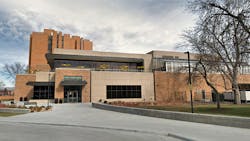Commons building at University of Colorado Boulder gets LEED Platinum
The Village Center Dining and Community Commons at the University of Colorado Boulder has been awarded Platinum certification by the United States Green Building Council.
The university describes the center, which opened in 2017, as a hub of student life on CU Boulder’s Williams Village campus.
In addition to the dining center, the 113,225-square-foot Village Center features a host of services, from residential programs, to healthcare and counseling, to a campus startup hub for innovation and entrepreneurship.
Some of the notable sustainable features of the Village Center:
- Electrochromic glass external windows on the south and west sides of the building darken when direct sunlight hits them, which increases energy efficiency, eliminates the need for window blinds and leaves mountain views in sight all day long.
- A 140.5-kilowatt solar array offsets 16 percent of the building’s annual energy cost.
- A 3,000-square-foot aeroponic garden supplies the dining center with fresh salad greens and reduces the need for packing and transporting food from outside farms.
- A biodigester treats food waste, which creates an eco-friendly product that can be safely added to the wastewater system and reduces food composting collection costs.
- A smoothie station featuring a bicycle-powered blender.
- By cost, 31 percent of building materials are recycled, and 48 percent were manufactured and extracted from within 500 miles of the project site.More than 60 percent of construction waste was diverted from the landfill.
- Water-efficient flow and flush fixtures coupled with an efficient irrigation system and native and adaptive plants used in landscaping are expected to result in more than 450,000 gallons of reduced water use each year.
- A 38 percent energy use savings compared with a similar baseline building.
- LED lighting throughout the building.
- The entire second-floor dining center seating area uses daylighting (along with skylights) in lieu of artificial light between the hours of 9 a.m. and 3 p.m.
- About 40 percent of dining room chairs are made completely of recycled plastic material—111 20-ounce plastic bottles in each of the 181 chairs, to be precise.
- Six custom wood dining tables, each seating 12 people, were built using 100 percent beetle-kill wood from the Kremmling, Colo., area.
The LEED rating for the Village Center Dining and Community Commons brings the number of buildings on campus with the LEED Platinum certification to 11. CU Boulder has 28 LEED-certified buildings in all—11 Platinum, 16 Gold and one Silver.
Williams Village is a residential campus that will house about 3,600 students this fall. The new 700-bed Williams Village East residence hall is set to opes this fall and is aiming to receive Platinum certification.
“Our students care about sustainability and environmental impact,” says Christina Gonzales, CU Boulder vice chancellor for student affairs. “So as we build and renovate our residence halls and buildings we’ve made sure sustainability is front and center in the designs. By recommending a greenhouse and eco-friendly solutions, our students played a key role in the design and development of the Village Center. The Village Center is also a shining example that came to fruition through the collaboration of many campus departments.”
About the Author
Mike Kennedy
Senior Editor
Mike Kennedy, senior editor, has written for AS&U on a wide range of educational issues since 1999.
